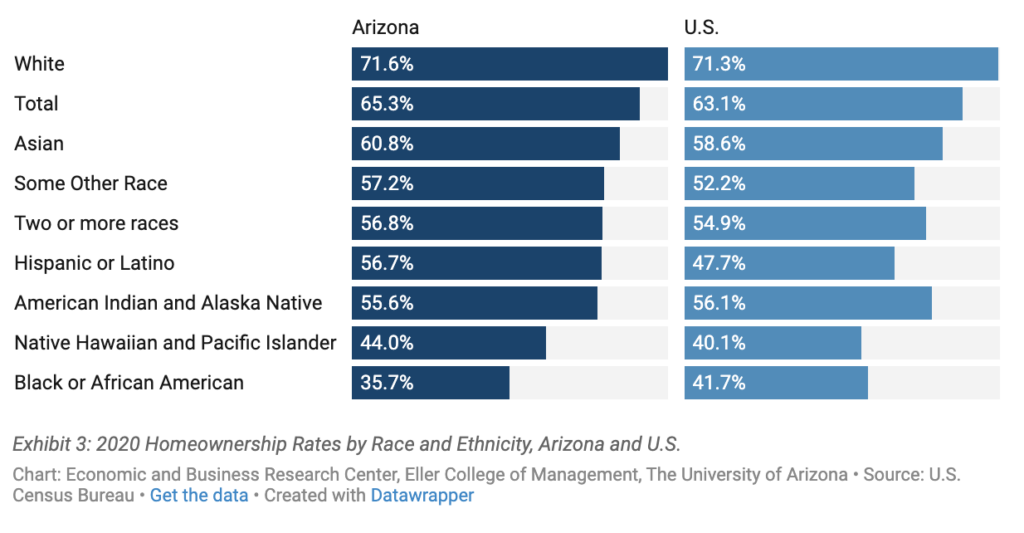Arizona housing units rose 8.3% from 2010 to 2020. This article reports on housing in Arizona based on the 2020 Census. It will look at what changed over the decade between 2010 and 2020, how the 2020 data compares to the nation, to other states, within Arizona, and in some cases, by race and ethnicity.
LEARN MORE: The wow factors that sell a home in the current market
Most Arizona counties had an increase in the number of housing units between 2010 and 2020. The counties with the most substantial growth in housing were Maricopa (10.6%), Yavapai (9.7%), Coconino (9.1%), and Pinal (8.6%), all of which grew at a faster rate than the nation. The U.S. had an increase of 6.7% in housing units during this time. There were five counties in the state with fewer housing units in 2020 than they had in 2010. These were La Paz (-16.2%), Apache (-11.7%), Navajo (-1.3%), and Cochise (-0.7%). Exhibit 1 displays the counties in Arizona, their housing units in 2020, and the % change over the decade.
Interestingly, Maricopa County had the fourth largest total number of housing units in the nation in 2020, behind Harris, TX; Cook, IL; and Los Angeles, CA. There were 1,812,827 housing units in Maricopa County in 2020, an increase of more than 10 percent from 2010.
Exhibit 1: Number of Housing Units in Arizona Counties for 2020 and Percent Change from 2010

Arizona was among the top third of states with an 8.3% increase in growth in housing units over the decade. The District of Columbia topped all states with an increase of 18.1%, while the state growing the most was Utah at 17.5%, followed by North Dakota at 16.7%.
Let’s turn to occupied housing units. Housing tenure is characterized by occupancy status: ownership with a mortgage or loan, owned free and clear, or renter occupied. Around a third of the housing in the nation is renter-occupied. In Arizona, the percentage of rented housing units ranges from 20.4% in Pinal to 55.7% in Greenlee. Households owned by the occupants usually have a mortgage or a loan. There were, however, five counties where the number of houses owned outright without a mortgage or loan was larger than the number with mortgages. These were Apache, Gila, Greenlee, La Paz, and Navajo.
The homeownership rate is the proportion of households that are owner-occupied (either with a mortgage or owned free and clear). The homeownership rate for Arizona in 2020 was 65.3%, a bit higher than the nation at 63.1%. Homeownership was highest in Pinal County, with a rate of 79.6%, followed by Gila at 75.9% and Yavapai at 73.5%. Three Arizona counties had a homeownership rate lower than the nation in 2020 – Maricopa at 63.0%, Coconino at 59.2%, and Greenlee at 44.3%.
Homeownership declined over the decade for the nation, as well as most areas in Arizona. Two counties in the state had a marked increase in homeownership between 2010 and 2020: Pinal, moving up 3.5 percentage points, and Yavapai, moving up 2.7 percentage points. La Paz and Greenlee had the most substantial decreases in homeownership over the decade. La Paz County had the highest rate in 2010, but was far from the highest in 2020 as Pinal rose to the top, surpassing both La Paz and Gila. Exhibit 2 ranks homeownership in Arizona counties for 2010 and 2020.
Exhibit 2: Homeownership Rates by County, 2020 and 2010

Homeownership rate data are available by race and ethnicity and are worth examining. As with the total homeownership rate, Arizona does better than the nation for most race and ethnicity categories. The two exceptions to this were American Indian and Alaska Natives, which was just slightly lower than the U.S., and Black or African Americans, which was six percentage points lower than the nation. (For comparability, all references of race here are for the category alone, not Hispanic while Hispanic or Latino is listed alongside race categories.) White homeownership had the highest rate in Arizona at 71.6%. At 35.7%, the Black homeownership rate was the lowest in the state, less than half that of white homeownership. The rate for the Native Hawaiian and Other Pacific Islander category was second lowest in Arizona at 44.0% and was the category with the lowest homeownership rate for the nation at 40.1%. The Arizona Hispanic or Latino homeownership rate was 56.7%, far exceeding the U.S. rate of 47.7% (Exhibit 3). Hispanic or Latino homeownership rates in the state substantially outpaced the nation, as did the category of Some Other Race.
Exhibit 3: Homeownership Rates by Race and Ethnicity, Arizona and U.S.

Despite the increased number of housing units between 2010 and 2020, the proportion that were empty decreased. A little less than 10 percent of housing in the U.S. was vacant in 2020, down from over 11 percent in 2010. In 2020, 12.2% of housing in Arizona was vacant, 4.1 percentage points lower than the decade prior (Exhibit 4). The percentage of vacant housing units varied greatly among Arizona counties. Pima County had the fewest vacant housing units in 2020 at 9.2%, followed by Maricopa at 9.3%. Both of these were lower than the nation, at 9.7%, and the state, at 12.2%. La Paz County had the largest share of vacant housing units in 2020 at 45.2% and was the only county in Arizona to have an increase in the percentage of empty housing. A housing unit is noted as vacant if no one is living in it on Census Day unless the occupant(s) are away temporarily and will be returning, such as on a business trip, vacation, or short hospital stay. Houses that are occupied by persons who have a usual residence elsewhere were considered vacant when enumerated.
Exhibit 4: Percent of Vacant Housing Units, 2020 and 2010

Houses can be vacant for many reasons, such as being for sale or rent and sold or rented but not yet occupied. The primary reason, however, is for seasonal, recreational, or occasional use, such as vacation or winter homes. This was the case for the nation, for Arizona, and most counties within the state. More than half of vacant housing units for 2020 were for seasonal, recreational, or occasional purposes in La Paz, Navajo, Coconino, Gila, Yuma, Mohave, Pinal, Apache, and Yavapai counties. La Paz had the highest percentage of seasonal use at 81.2% (Exhibit 5). A third or more of vacant housing units in Maricopa, Santa Cruz, and Pima were for seasonal use. Nationally, 31.9% of vacant housing was for seasonal, recreational, or occasional use while in Arizona it was 48.6%.
Only three counties claimed something other than seasonal use as the primary vacancy status. The highest percentage of vacant housing units in Greenlee was for rent, and, in Cochise and Graham counties, the category of other vacant was the most prominent status. The other vacant category is listed when reasons for the unit being empty do not fall into any of the other categories, for example, it could be held for a caretaker or vacant for personal reasons of the owner.
Exhibit 5: Share of Vacant Housing for Seasonal, Recreational, Or Occasional Use, 2020
Given that property for rent was the largest percentage of vacant housing in Greenlee County, it is no surprise that the available housing vacancy rate in that county would be the highest in Arizona. The available housing vacancy rate, or the proportion of housing inventory that is vacant on account of being for sale or rent, was 7.7% in Greenlee County for 2020. The rate for Arizona was 4.2%. Counties with the smallest share of housing available for rent or sale in 2020 were Apache (2.6%), Pinal (3.6%), and Yavapai (3.6%), all of which were lower than the national figure of 3.8%.
Author: Valorie H. Rice is the Senior Business Information Specialist at the Economic and Business Research Center (EBRC) in the University of Arizona’s Eller College of Management.




